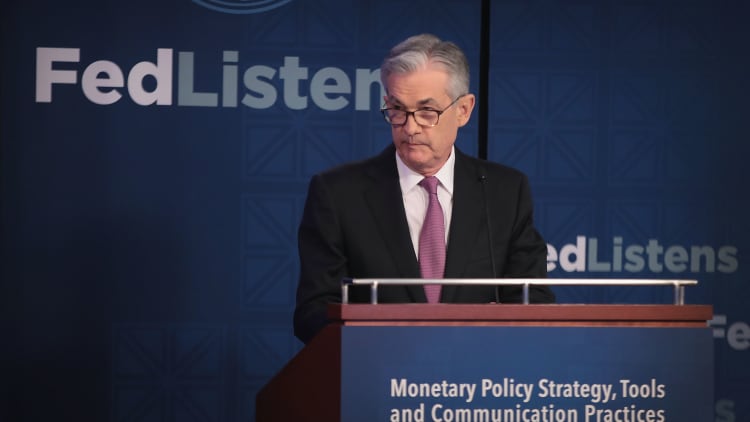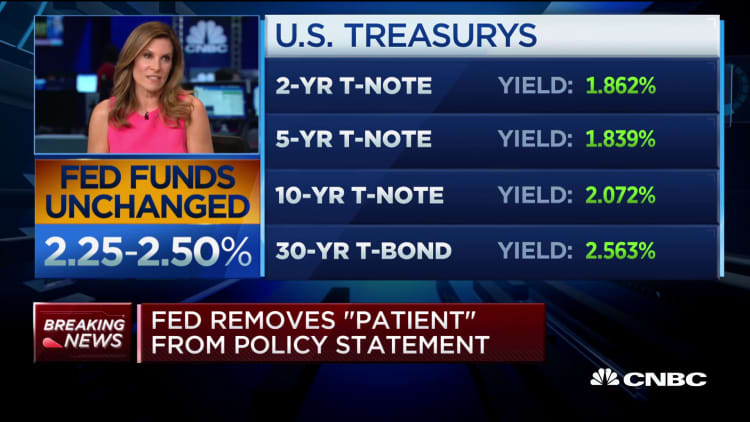
A divided Federal Reserve held the line on interest rates Wednesday and indicated formally that no cuts are coming in 2019. The decision came amid divisions over what is ahead and still leaves open the possibility that policy loosening could happen before the end of the year depending on how conditions unfold.
The central bank predicts one or two rate cuts in its set of economic predictions, but not until 2020. Despite cautious wording in the post-meeting statement Wednesday, markets are still betting the Fed cuts, as soon as July.
And Powell opened the door to that possibility in a press conference following the statement, saying, "Many participants now see the case for somewhat more accommodative policy has strengthened."
In a decision closely watched by financial market participants clamoring for multiple cuts, central bank officials on the Federal Open Market Committee voted 9-1 to keep the benchmark rate in a target range of 2.25% to 2.5%, where it has been since December's controversial quarter-point increase. St. Louis Fed President James Bullard voted to reduce the rate.

The action sets up a possible confrontation between Fed Chairman Jerome Powell and President Donald Trump, who has been pressuring the Fed to cut rates. Just Tuesday, Trump said "let's see what he does" at the Fed meeting when asked if he still wants to demote Powell.
At the post-statement news conference, Powell was asked about his future as chairman. "I think the law is clear that I have a four year term, and I fully intend to serve it," he said.
The strong majority for this month's decision contrasted with a sharp difference of opinion on what happens next.
The committee provided an important nod to those worried about slower growth: It dropped the word "patient" in describing its approach to policy. The characterization was a key part of the Fed "pivot" earlier this year that signaled to the market a more dovish approach to rates.
"The Fed didn't surprise investors with the decision to maintain rates, but the split vote tells us that a cut is on the way and it's increasingly likely that will be in July, as bond markets have been hoping," said Neil Birrell, chief investment officer at Premier Asset Management.
"This was probably the compromise decision — it wasn't shocking and should offer some reassurance," Steve Rick, chief economist at CUNA Mutual Group, said in a note. "The FOMC will still want to closely monitor the stress fractures from the bond market, middling housing and auto sales numbers, and an increasingly uncertain global economic landscape in the coming months."
The statement also changed wording to concede that inflation is "running below" the Fed's 2% objective. In their forecast for headline inflation this year, officials slashed the estimate to 1.5% from March's 1.8%. Core inflation, which excludes volatile food and energy prices, is likely now to be 1.8% from March's 2%, according to the quarterly summary of economic projections also released Wednesday.
'In light of these uncertainties'
The committee changed language from its May statement to indicate that economic activity is "rising at a moderate rate," a downgrade from "solid."
In their baseline scenario, FOMC members said they still expect "sustained expansion of economic activity" and a move toward 2% inflation, but realize that "uncertainties about this outlook have increased."
"In light of these uncertainties and muted inflation pressures, the Committee will closely monitor the implications of incoming information for the economic outlook and will act as appropriate to sustain the expansion, with a strong labor market and inflation near its symmetric 2 percent objective," the statement said. The "act as appropriate to sustain the expansion" language mirrors a statement from Powell in early June.

The committee characterized the labor market as "strong" with "solid" jobs growth, despite May's disappointing nonfarm payrolls growth of 75,000. The statement further said that household spending "appears to have picked up from earlier in the year."
The changes came amid what appeared to be little consensus among the committee about where rates go next.
Divided Fed
According to the "dot plot" of individual members' expectations, eight members favor one cut this year while the same number voted in favor of the status quo and one still wants a rate hike. Bullard and Minneapolis Fed President Neel Kashkari have led the public discussion about the potential for rate cuts, while other members have been less firm.
Into 2020, the Fed consensus was a bit stronger, with nine members wanting a cut to a funds rate around 2.1%. The direction changes, though, in 2021, with indications of an increase of about a quarter-point, culminating in an expected long-run value of 2.5%. The funds rate most recently was trading at 2.37%.
Traders in the thin and volatile funds market had been pricing in a 26% chance of a cut at this week's meeting. Later in the year, though, the probability for a July easing rose to 82.5% and the chances of a second cut in December were most recently at 60.4%. The market expects a third cut to come around March of 2020.
While the statement language offered some significant changes, estimates in the summary of economic projections, other than inflation, moved little from March. GDP growth is still expected to be 2.1% for the year – it was 3.1% in the first quarter, and the Atlanta Fed is forecasting a 2% gain in the second quarter. The unemployment rate is now expected to hold at a 50-year low of 3.6%, against the March forecast of 3.7%.


